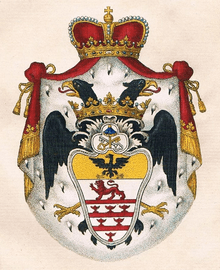Erba-Odescalchi
Erba-Odescalchi (IPA: [ˈɛrba odeˈskalki]), or just Odescalchi, is the name of an Italian noble family of princely rank. With the election of Benedetto Odescalchi as Pope Innocent XI in 1676, members of his family advanced in social status from bankers to members of the high aristocracy.

History
The Odescalchi family were entrepreneurs with the minor nobility of Como.[1] They trace their family line to Giorgio Odescalchi of Como, around 1290.
Pietro Giorgio Odescalchi was Bishop of Alessandria (1598-1610) and then Bishop of Vigevano (1610–1620).[2]
Benedetto Odescalchi reigned as Pope Innocent XI from 1676 until 1689. As the last male heir to the family, their fortune passed to the descendants of his sister, Lucrezia Odescalchi, who had married Alessandro Erba in 1621. The Erba family is allegedly descended from Enrico Erba, an Imperial vicar in Milan, around 1165. The title of Prince of the Holy Roman Empire was conferred on their grandson Baldassare Erba-Odescalchi in 1714, along with the title, Duke of Syrmia in the Kingdom of Hungary and the qualification of Serene Highness.
The Pope's grand-nephew Cardinal Benedetto Erba Odescalchi held a doctorate in Civil and Canon Law (Pavia, 1700), and was Papal Nuncio in Poland from 1712 to 1714. He was named Archbishop of Milan in 1712 (resigning in 1736 after a stroke), and was created a cardinal in January 1714. He died in Milan on 13 December 1740.[3]
Antonio Maria Erba-Odescalchi, Pope Innocent's great-grandnephew and Cardinal Benedetto Erba-Odescalchi's nephew, was a Doctor in Civil and Canon Law (Milan 1733), which allowed him to pursue a career in the Papal Court in Rome as a church lawyer. He became a Protonotary Apostolic in 1737 and a Referendary (Judge) of the Two Tribunals of Justice and Grace in 1739. He was named a cardinal in 1759 and given the office of Vicar-General of the Pope for the City of Rome. He died in 1762.[4]
Carlo Odescalchi, S.J.,[5] was the son of Prince Baldassare Erba-Odescalchi, and Valeria Caterina Giustiniani. His family was in exile in Hungary during his youth, having fled the French forces of First Consul Bonaparte. He obtained a Doctorate in Civil and Canon Law. Pope Pius VII sent him on several minor diplomatic missions to Hungary. He became Auditor (Judge) of the Sacred Roman Rota in 1815, and joined the restored Society of Jesus in 1818. He was promoted Auditor of His Holiness and Canon of the Vatican Basilica. On 10 March 1823 Odescalchi was created a cardinal and named Archbishop of Ferrara; he resigned the diocese in 1826 to pursue a higher career in the Papal Curia as Prefect of the Congregation of Bishops and Regulars. He was named Bishop of Sabina in 1833; he resigned in 1838 to return to the Jesuits. He died in Modena in 1841.[6]
Banking
In 1619, Benedetto's brother and three uncles founded a bank in Genoa, which grew into a successful money-lending business. After completing his studies in grammar and letters, the 15-year-old Benedetto moved to Genoa to take part in the family business as an apprentice. The family established lucrative financial transactions with clients in major Italian and European cities, such as Nuremberg, Milan, Kraków, and Rome.
Twentieth century
In the 20th century, Prince Karoly Odescalchi and his son, Prince Paul, were members of the Hungarian resistance to Nazism, as well as Communism.[7]
The head of the family now bears titles including Prince Odescalchi, Duke of Sirmium, and Prince of Bassano. Prince Odescalchi is a Hereditary Magnate of Hungary and Grandee of Spain. The family owns the Palazzo Odescalchi in Rome, the Orsini-Odescalchi Castle in Bracciano, as well as large estates in Italy, Croatia (Ilok Castle) and Hungary. The castle in Bracciano was originally an Orsini family fortress until it was sold to pay debts.
The Princely family is currently represented by Prince Carlo Odescalchi, Prince of the Holy Roman Empire, Duke of Syrmium, etc. (b.1954), whose heir is his son Prince Baldassare Odescalchi (b.1993).
References
- Williams, George (1988). Papal Genealogy: The Families and Descendants of the Popes. Jefferson, North Carolina: McFarland & Company Inc. pp. 120–121. ISBN 0-7864-2071-5.
- Giovanni Maria Ferraria (1682). Vita del venerabile seruo di dio m.or Pietro Giorgio Odescalchi vescouo prima d'Alessandria, e poi di Vigeuano (in Italian). Vigevano: nella stampa vescouale per Camillo Corrada.
- Miranda, Salvador. "ERBA-ODESCALCHI, Benedetto (1679-1740)". The Cardinals of the Holy Roman Church. Florida International University. OCLC 53276621.
- Miranda, Salvador. "ERBA-ODESCALCHI, Antonio Maria (1712-1762)". The Cardinals of the Holy Roman Church. Florida International University.
- Antonio Angelini (1855). Storia della vita del padre Carlo Odescalchi della Compagnia di Gesu scritta da Antonio Angelini della medesima Compagnia . (in Italian). Napoli: Perrotti. Théophile Bérengier (1880). Vita del cardinale Carlo Odescalchi morto religioso della Compagnia di Gesù: (1785-1841) (in Italian). Venezia: Tipografia emiliana.
- Miranda, Salvador. "ODESCALCHI, S.J., Carlo (1785-1841)". The Cardinals of the Holy Roman Church. Florida International University.
- "Obituary: Prince Paul Odescalchi". Daily Telegraph.
Sources
- Bianchi, Eugenia (2012). Gli Odescalchi a Como e Innocenzo XI : committenti, artisti, cantieri. Como : Nodo libri. (in Italian)
- Bucci, Ferdinando (2009). Il Castello Orsini-Odescalchi di Bracciano : storia, tesori e segreti. Manziana (Roma) : Vecchiarelli. (in Italian)
- De Syrmia, Edmond (1978). At the head of nations : the rise of the papal and princely House of Odescalchi. Pleasant Valley, N.Y. : Cyclopedia Pub. Co.
- Mira, Giuseppe (1940). Vicende economiche di una famiglia italiana dal XIV al XVIII secolo (in Italian). Milan: Società editrice "Vita e pensiero,".
- Original 1922 Almanach de Gotha (edited by Justice Perthes) entry for the Odescalchi family
External links
- A. von Reumont, Geschichte der Stadt Rom (Berlin, 1868)
![]()